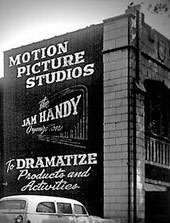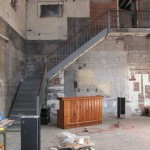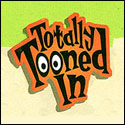
I had an incredible time last weekend in Detroit Michigan, presenting a screening at the Detroit Institute of Arts and visiting with Steve Stanchfield. Let me say again that if you can get to Detroit anytime before January 5th, I highly recommend you do so. The current animation exhibit Watch Me Move is a must-see. The weekly film programs of classic animation are expertly curated and guest speakers they have lined up – Leslie Iwerks (Nov. 2nd), Paul Dini and Alan Burnett (Nov. 16th) – are great (I should know, they are all friends of mine).
 One of the highlights of my trip was a little tour of Detroit by Steve, along with Mary Dixon (aka “Mary in Ann Arbor” to you Stephanie Miller fans). Of course, for animation fans no trip to Detroit is complete without a “visit to mecca”: the sacred holy land that is the “Jam Handy” building.
One of the highlights of my trip was a little tour of Detroit by Steve, along with Mary Dixon (aka “Mary in Ann Arbor” to you Stephanie Miller fans). Of course, for animation fans no trip to Detroit is complete without a “visit to mecca”: the sacred holy land that is the “Jam Handy” building.
Of course, the building today is a shadow of its former self (click thumbnails below to enlarge). The good news is that a local support group, Detroit Soup, has purchased the building and intends to rehabilitate it into a community arts space. They are still calling it “The Jam Handy” so I can only hope the will restore the signage on the building (if you squint you can still see the ghosts of the Jam Handy lettering on the blue marquee).
The building is a shrine to classic cartoon animation – and a landmark location in film history. Who worked there? Max Fleischer, Gene Deitch, Rudy Zamora, Roy Williams, Jim Tyer to name but a few. What films did they make? Usually commercial, industrial and educational shorts – and many for nearby General Motors. Rudolph The Red-Nosed Reindeer was one of their few theatricals. Below are several of the Chevrolet/Nicky Nome pictures Handy produced between 1936-1938. Heck, they’re as good as anything Ted Eshbaugh or Amadee Van Beuren were producing just a few years earlier… and most enjoyable in their own right.
So here’s to the historic Jam Handy Building – may you continue to survive, and go on to inspire others with your legacy of excellence.






 Jerry Beck is a writer, animation producer, college professor and author of more than 15 books on animation history. He is a former studio exec with Nickelodeon Movies and Disney, and has written for The Hollywood Reporter and Variety. He has curated cartoons for DVD and blu-ray compilations and has lent his expertise to dozens of bonus documentaries and audio commentaries on such. Beck is currently on the faculty of Cal Arts in Valencia, UCLA in Westwood and Woodbury University in Burbank – teaching animation history. More about Jerry Beck [
Jerry Beck is a writer, animation producer, college professor and author of more than 15 books on animation history. He is a former studio exec with Nickelodeon Movies and Disney, and has written for The Hollywood Reporter and Variety. He has curated cartoons for DVD and blu-ray compilations and has lent his expertise to dozens of bonus documentaries and audio commentaries on such. Beck is currently on the faculty of Cal Arts in Valencia, UCLA in Westwood and Woodbury University in Burbank – teaching animation history. More about Jerry Beck [







During what years was Jam Handy in business, and did they occupy this building the whole time?
I know the company lasted into the 70’s but I believe by then they weren’t doing much with animation anyway, but if Ray Pointer happens to show up here, he’ll correct me or further on the question asked.
The Jam Handy Organization was established in 1924, the same year as the merger that created General Motors. It was the result of Mr. Handy’s being fired from the Bray Studio in what amounted to a breach of contract when Bray got into litigation issues over patent infringements and his breach with Goldwyn when he contracted for more films than he could deliver.
Mr. Handy was a two-time Olympic swimmer from The University of Michigan. He came from a family of Journalists associated with the Chicago Tribune. Following his Olympic triumphs, he was offered positions for corporate sales due to the value of his name. Because of this, Bray hired him as Vice President of Industrial films, and he acquired many valuable automobile accounts. When Bray dismissed him, Handy took his accounts with him. For two years he operated Diamond Productions in Chicago. He told me once that during this period Walt Disney worked for him for a week and they had to fired him because he didn’t draw well enough. While this does not seem to follow the official Disney Timeline, it is an interest story, typical of the sour grapes attitude that permeated at the company.
The Jam Handy Organization became a total presentation/advertising company, producing demonstration films and stage shows for fairs and conventions. They expanded their animation department in the 1930s, and Mr. Handy proudly declared how they obtained the licenses for cel production from his former employer, John Bray. From what I was told, they had what was considered a large department consisting to two divisions, one for theatrical cartoon animation and the other devoted to Technical Animation. The two divisions were in constant opposition to each other, and there was a lack of stability in managing the two for more efficient operation of production until the arrival of Max Fleischer in 1942. Those remembering Max there said aside from his state of illness, had noting but complimentary things to say about how he brought stability to the department, understanding the methods for approaching the production of educational and industrial films. When Max left in 1953, Gene Deitch had already been there two years and affected a major revolution that they were still talking about when I came there nearly 50 years ago. I was thrilled to pieces being around everything I’d seen in books and was now able to touch and work with, being asked to do various things from one day to the next. It was on the job training in the old studio system on a small scale. That simply does not exist any longer. But that short exposure was something I will always remember.
oh my GOURD! These films are fantastick!!
What? No Ray Pointer?
IT WOULD BE WONDERFUL TO HAVE ALL THE JAM HANDY’S CHEVROLET ADS AND MAX FLEISCHER’S RED NOSE REINDEER SHORT IN ONE OF STEVE’S THUNDERBEAN FUTURE RELEASES.
Perhaps for what it is. But the RUDOLPH film, while it served its purpose for Montgomery Ward, it was a poor reflection of the quality of animation the company had been producing. It is an indication of how budgets were being cut after World War II even for industrial films. This is where the design and stylization approach that Gene Deitch brought in in 1951 gave rebirth to Jam Handy’s animation department.
Jerry, it’s articles, photos and video clips like these that keep me returning to Cartoon Research again and again.
THANK YOU.
I’m delighted you got to visit the historic Jam Handy building!
Sincerely,
William Carroll
Denham Springs, Louisiana
Jeez- they had few scruples about recycling a number of elements straight out of the Fleischer Betty Boop feature into “A Coach for Cinderella”
Robert, I think you are mistaken in your perception. I don’t know what you refer to as recycling from Fleischer on A COACH FOR CINDERELLA. Frankly, it’s not very well drawn, and the direction a bit meandering. But they had the ego of the Chevrolet sales people, so the goal was to satisfy the client. Frank Goldman, Max’s best friend directed this one. The sequels were farmed out, which is obvious since the animation in those is superior. A RIDE FOR CINDERELLA has animation by Jim Tyer, by the way. This I know for a fact. I am not certain about his working on JUST IMAGINE since this does not look like his work to me. JUST IMAGINE was produced during the period that Max Fleischer was head of the Animation Department, and he brought in several of his New York animators on several productions because most of the Detroit animators at Handy’s were not very good. The stop motion in JUST IMAGINE was done by Frank, by the way.
For the record, that is NOT the “Jam Handy Building, ” folks. It was only one of them. That was the sound stage. There were offices upstairs were some of the writers were. The majority of the operation was spread out in five more buildings on both sides of East Grand Boulevard the next two blocks down towards Hastings. At the time, the Boulevard had an Elm lined median dividing east and west bound traffic. There were also 12 foot lawns reaching out from the buildings. The Animation Department when I knew of it was on the second floor on a two story building two blocks down from the sound stage. It was located in the back half. They had four Oxberry Master Animation Cameras located on four places in the room. There was a long table with a T-Shaped shelf over it with electrical outlets all along the edge. There were additional electrical outlets hanging from the ceiling. There were two entrances on the south and north ends of the room. The north door would be closed then film was projected in there, the screen being on the north wall. The screen had a graph on it showing the degree of cropping for projection and television transmission. This they used to determine the amount of cutoff they had and also determine whether artwork shot outside of the film aperture would be cropped because of an error in layout or faulty camera direction. In 1970 they moved the department across the street to a taller building and into a rather depressing area that looked like something you’d find at a refinery or paint factory. They had a few rooms there, and only one camera set up in a room to itself. The staff had been laid off, and came in working freelance. Joe Petrovich was head of this non-existent Animation Department by this time. He eventually left and went into business with Skip Sharron in 1972 with a little studio in Royal Oak called “Cartoon Factory.” My arrival at the Jam Handy Animation Department was when it was on its last legs. But nevertheless, I was there. So was Max Fleischer!
DOWN THE GASOLINE TRAIL is an earlier one you should see. https://www.youtube.com/watch?v=1SfIe56gpcU
By the way, I have that black and white still taken from the side parking lot of the sound stage.
I worked at Jam Handy right out of college and spent a lot of time with Mr. Handy. The place was rich with seasoned pros and steeped in history. It was the best mentoring program anyone could have imagined. I still look back and cherish that fact I spent time driving Mr. Handy, having lunch with him and the other “old timers”. It is an experience that sadly will never be available to others today. I’ll carry my memories of Loma and Buzz and Fred and Mr. Handy forever. Or until I lose my mind.
I think the Jam Handy picture were absolutely sensational, can say enough how masterful and excellent they were in every way, the music (Detroit Symphony Orchestra! can you imaging such a thing today in that city.) and the editing and the camera work. Fantastic filming. And the way the narrators spoke, so clearly, you could understand every word. No slurred speech, no vowels spoken all as “uh” they way it is today, and so forth. One picture stands out in memory, called “Master Hands” about the mfr of Chevrolet cars in I think 1936. Absolutely brilliant. So sad that this all has gone away. All gone, gone forever. Detroit today, a ruin.
Enjoyed the visit!! I am a retired Art History Professor. I used some ” sound filmstrips in color” with printed instructional material from the Jam Handy organization in my early lectures. I was cleaning out the basement, which brought me to your site!! The strips are long gone but were from “The Western Art Series” dated 1968. I found no mention of “art instruction” in my on-line search, but the address listed on the back of the manual was: The Jam Handy Organization, 2821 E. Grand Blvd., Detroit, Mich, 48211. So I think I have found the Jam I was looking for. Any further information on my stuff?
I worked at Jam Handy after I graduated from high School in 1963 until I went into the Air Force in September of 1965. I started in the mailroom so I visited all of the Jam Handy buildings. The building at 2821 E. Grand Blvd. was the main headquarters building. It housed Mr. Handy’s office and many of the administration offices. There was also a large still photo studio, the editorial department (including a great library where I spent many lunch hours!), and the slide film department (which seemed to be the biggest income producer at the time). Across the Boulevard was another large building (2792? – now mostly gone) which held the above mentioned animation department (another favorite hangout), a small letterpress print shop, and many other offices that I don’t remember.
About a block west of this building (2900) was the live action film department and sound stage. I believe the building east of the main 2821 building (2817) was also a Jam Handy building, since I seem to remember a shipping department located in the rear of that building (not 100% sure of this – it was a long time ago). Further east, I recall a single story building that housed the offset printing shop. There was also an office in the GM Building for the VP of the GM account. We made twice daily trips to the GM Building to deliver and collect mail, and occasionally pickup Mr. Handy’s suits (always blue) from the cleaners.
My last year at Jam Handy, I worked in the slide film department as a production router. I returned briefly in 1970 after I got out of the Air Force, working as an apprentice art director, but things seemed to be starting to change – not in a good way.
I”m glad to see your accounts of Handy’s Allan. For a long time it looked like I was the only one talking about this. Thanks for your comments. This is important because we are the last generation alive that was ever in the place when it was still an active production company.
I grew up in Michigan and was never even aware of Jam Handy studios. I am an avid fan of Mystery Science Theater 3000, who has “presented” six of their short films. Upon some research, I found out their origins.
Hola buenas noches !! les escribo desde Argentina, necesito información sobre unas diapositivas que conseguí sobre Coca Cola , las mismas fueron hechas por The Jam Handy organization, esperando su respuesta, saludo atte !!
Google Translation: Hello Goodnight !! I write to you from Argentina, I need information about some slides that I got about Coca Cola, they were made by The Jam Handy organization, waiting for your answer, greeting atte !!
Reading all this brings back such happy memories of going to work with my Dad on Saturday mornings to Jam Handy, and ambling down the hall to the animator’s room…guys talking to me like Mickey Mouse, hanging out in the dark timing room with my Dad and watching Rudolph…I am so very proud.
My great grandfather- George Chandler Wood- worked for Jam Handy but during what time period I am unsure; Late forties into fifties possibly. Do records of former employees and their work projects still exist? He was also a former employee to Disney before studio’s move to California. I would be interested in any information that might exist regarding my great grandfather as he died in 1965 shortly before I was born…
Sincerely, Edye Martin